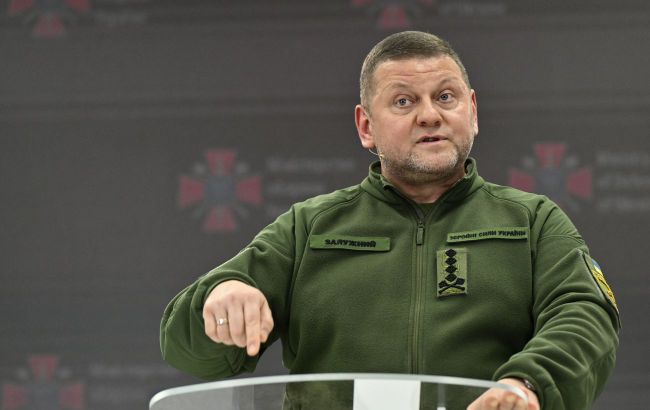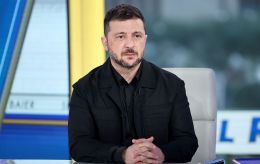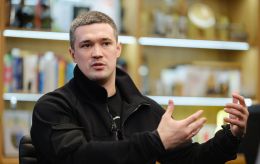Commander-in-Chief of Armed Forces of Ukraine talks about front, mobilization, weapons for breakthrough
 Commander-in-Chief of the Armed Forces of Ukraine, General, Valerii Zaluzhnyi (photo: Getty Images)
Commander-in-Chief of the Armed Forces of Ukraine, General, Valerii Zaluzhnyi (photo: Getty Images)
Commander-in-Chief of the Armed Forces of Ukraine, General, Valerii Zaluzhnyi, maintains limited communication with journalists. He conveys his assessments and views on the Russia-Ukraine war through rare articles and briefings for media representatives.
Here is a compilation of the key statements made by the military commander regarding the war.
In the preparation of this article, interviews and essays by Zaluzhnyi for The Economist, as well as statements from the December briefing, were used.
About the concept of leadership and trust in generals
In December 2022, Zaluzhnyi stated that the concept of a Soviet-style commander in the Ukrainian army had not been effective since 2014.
"Of course, we had our own derzhimordas who tried to keep order with their fists and biceps, but it does not work 100% in the Ukrainian army… It is always possible to be normal. To be normal means to remain human in any situation—that is the most important thing. To remain human, to become a leader. To be smarter, to be stronger, to be more talented, and in that case try to manage people. That is a religion I practised," emphasised Zaluzhnyi.
He also assured that he trusted his generals.
"Since the start of the war, I fired ten of them because they were not up to it. Another one shot himself. I trust Syrskii [General Oleksandr Syrskii, commander of Ukraine’s land forces]. If he tells me he needs another brigade, it means that he really needs another brigade. I certainly don’t think I am the smartest one here," said Zaluzhnyi.
About 300 tanks to reach the frontline by February 23
Zaluzhnyi gave the interview against the backdrop of successful counteroffensive operations in the Kharkiv and Kherson regions. At that time, according to his words, the strategic task was to hold the line and prepare for a new Russian offensive in the Donbas.
"We have made all the calculations - how many tanks, artillery we need, and so on and so on. I know that I can beat this enemy. But I need resources. I need 300 tanks, 600-700 IFVs, 500 Howitzers. Then, I think it is completely realistic to get to the lines of February 23rd. But I can’t do it with two brigades. I get what I get, but it is less than what I need," he said.
At that time, he was generally satisfied with the pace of mobilization.
"We are already conducting it as it is. We have enough people, and I can clearly see what I have. I have enough. I don’t need hundreds of thousands more," emphasized Zaluzhnyi just over a year ago.
About the blind spot on the front, trench warfare, and the necessity of technological breakthrough
Nearly a year ago, Zaluzhnyi penned a column for The Economist, coinciding with the realization that the summer campaign in the south did not achieve its intended goal. Assessing the campaign, he noted that the battlefield resembled a major conflict from a century ago.
"Just like in the First World War, we have reached the level of technology that puts us into a stalemate. There will most likely be no deep and beautiful breakthrough," the general observed.
At that time, he warned of impending trench warfare and its risks.
"However, the war is now moving to a new stage: what we in the military call positional warfare of static and attritional fighting, as in the First World War, in contrast to the maneuver warfare of movement and speed. This will benefit Russia, allowing it to rebuild its military power, eventually threatening Ukraine’s Armed Forces and the state itself," he noted.
To break free from it, capabilities and technologies of a different order are necessary. Firstly, control over the skies. However, the general believed that F-16 fighters, set to appear in 2024, might be less useful because Russia improved its air defense. Secondly, electronic warfare is key to winning in drone warfare. Thirdly, counter-battery warfare – the destruction of enemy artillery.
"When we first received Western guns last year, we were quite successful at locating and striking Russian artillery. But the effectiveness of weapons such as Excalibur, a GPS-guided American shell, has declined dramatically owing to improved Russian electronic warfare," Zaluzhnyi wrote.
As the fourth priority, he named technologies to overcome minefields, and as the fifth – the buildup of reserves.
"Russia has failed to capitalise on its hefty manpower advantage because Vladimir Putin is worried that a general mobilisation might spark a political crisis, and because Russia cannot train and equip enough people. However, our capacity to train reserves on our territory is also limited," he added.
About underestimating Russia
Russia cannot be underestimated; it has suffered significant losses but will continue to outpace Ukraine for a long time in terms of armaments, technology, missiles, and ammunition.
"A positional war is a prolonged one that carries enormous risks to Ukraine’s armed forces and its state. If Ukraine is to escape from that trap, we will need all these things: air superiority, much-improved electronic warfare, and counter-battery capabilities, new mine-breaching technology, and the ability to mobilise and train more reserves. Innovative approaches can turn this 'positional' war into a 'maneuverable' one," noted Zaluzhnyi.
He admitted to underestimating Putin himself, thinking that high losses would force him into negotiations.
"That was my mistake. Russia has lost at least 150,000 dead. In any other country such casualties would have stopped the war," the general stated.
About the counteroffensive-2023
In June of last year, Ukraine initiated an offensive campaign in the south. As a result, a significant bulge was achieved in the area near the village of Robotyne in the Zaporizhzhia region, covering approximately 10 by 10 kilometers. Zaluzhnyi noted that according to the plan, the army was supposed to advance at a rate of 30 kilometers per day.
"If you look at NATO’s textbooks and at the maths which we did, four months should have been enough time for us to have reached Crimea, to have fought in Crimea, to return from Crimea, and to have gone back in and out again," said Zaluzhnyi.
However, the troops and equipment became stuck in minefields.
"First I thought there was something wrong with our commanders, so I changed some of them. Then I thought maybe our soldiers are not fit for purpose, so I moved soldiers in some brigades," he said.
When all this did not yield the desired results, Zaluzhnyi realized that the actual parity in technical equipment had put both the Armed Forces of Ukraine and the occupiers at a standstill.
About the delay of Western aid
Zaluzhnyi expressed disappointment over delays in arms deliveries from partners but did not consider it the main reason for Ukraine's challenging situation.
"It is important to understand that this war cannot be won with the weapons of the past generation and outdated methods. They will inevitably lead to procrastination and, as a result, defeat," stated the head of the Armed Forces.
Therefore, technologies will be of decisive importance. However, there are no signs that a technological breakthrough will happen soon in any of the spheres related to the war.
About the supposed new offensive by Ukraine. And about Russian plans
Regarding the alleged new offensive by Ukraine and Russian plans, a December report from the German publication Welt suggested the possibility of a new counteroffensive in 2024. According to expert Nico Lange, Ukraine's purported requests to the U.S. for Black Hawk and Apache helicopters, F-16 and F-18 fighters, Abrams tanks, long-range missile systems, UAVs, and ammunition seemed to indicate preparations.
"This is war, I cannot say what I plan or what we are supposed to do. Otherwise, it will be a show, not a war, the cost of which is human lives. This cannot be discussed in any way," replied Zaluzhnyi.
RBC-Ukraine also asked him to comment on the BILD publication, which, citing sources in German intelligence, discussed a mid-term Russian plan to capture Kharkiv, Dnipro, and Zaporizhzhia by the end of 2026.
"I would prefer not to comment on this process as it is not my area of expertise. The responsibility for it lies with those who have access to this information," replied the general.
About the situation in Avdiivka
At the end of 2023, the Russians launched an assault on Avdiivka and Maryinka near the occupied Donetsk. Even then, Russian propaganda claimed the capture of Maryinka. Zaluzhnyi noted that the city held on for almost two years, but when enemy shells plow the land along with people on a narrow piece of territory, the lives of Ukrainian soldiers become more important.
"As of today, our troops are still in the northern part. Our troops have prepared a defensive line outside this settlement. But I can say that this settlement no longer exists. The fact that we have now retreated to the outskirts of Maryinka and in some places have settled down behind Maryinka, I think, is nothing that can cause a public outcry. It (Maryinka - Ed.) is gone. Unfortunately," said the head of the Armed Forces.
As of the end of January, there was no official statement in Ukraine about the complete loss of Maryinka. Regarding Avdiivka, which had been under Russian assaults for one and a half months at that time, he requested not to create a mourning show.
"The conduct of hostilities follows its laws, which operate regardless of whether it is liked by commanders, politicians, or journalists. When the enemy delivers fire impact using a large number of shells, these shells have their result. They destroy buildings, they kill soldiers. The enemy has the opportunity to concentrate its forces, including artillery, and aviation assets in one or another direction... And he can do in 2 or 3 months with the city what happened to Bakhmut... Bakhmut or Avdiivka... we will defend as much as we have strength. If there is not enough strength, we will make a decision and save our people. And then we will recapture," he added.
About mobilization
In December, Ukrainians discussed President Volodymyr Zelenskyy's statement that the military requested the mobilization of an additional 500,000 people into the army. According to him, substantial arguments are needed for such a mobilization, as it would require an additional 500 billion hryvnias from the budget.
Zaluzhnyi clarified the situation. He did not specify the figure of 400 or 500 thousand but mentioned the overall need. He pointed out that it would be divided into specific periods.
"Some will be mobilized in January. And some will be mobilized in December (next year - editor's note). I will say that 2023 was exactly the same, following the same scheme. It will be done in the same way in 2024." he explained.
A revised bill has recently been submitted to the Verkhovna Rada, indicating an intensification of mobilization.
Zaluzhnyi also emphasized that, for him, the crucial point is that people who can perform the assigned tasks join the army. The decision on who will be conscripted is not within his competence.
"I need people, ammunition, weapons to continue fighting," he noted.
Regarding the introduction of electronic conscription, the general emphasized that he would welcome any initiatives that meet the need for personnel.
About the cancellation of the conscription service
The Commander-in-Chief of the Armed Forces of Ukraine believes that under the current conditions, the Ukrainian army does not need conscripted soldiers.
"As of the summer, we were not ready to discharge conscripts, but let's just say that somewhere around the end of November it was our absolute proposal. We applied to the Ministry of Defense to discharge conscripts from military service. As of today, they are no longer needed. Our clear position is to dismiss them so that they can go on vacation. And then we acted accordingly under the existing legislation, and we support the positions proposed in this draft law regarding their future fate," he emphasized.
According to the proposals, conscripts will be granted a 6-month deferment from mobilization after their release, and mandatory basic training will be introduced instead of conscription for men aged 18 to 25. Zaluzhnyi supports this initiative.
"I want them to come (to the army - editor's note) in a condition where they can do it. And if they are further prepared, I am all for it," the general said.
About the aid of allies in the preparation of brigades
Today, Ukraine, together with Western partners, can simultaneously prepare up to 10 brigades to defend against a Russian invasion. Each brigade may consist of 1,000 to 8,000 military personnel.
He explained that they had an excellent opportunity to leverage both their capabilities and those provided by their partners. He emphasized that their partners paid great attention to this aspect. In reality, he pointed out that their capabilities were not limited at that moment, and they could prepare up to 10 brigades in full.
About the work of Ukrainian territorial recruitment centers
Zaluzhnyi is dissatisfied with the work of the territorial recruitment centers (TRC).
"As of today, I'm not satisfied with their work. We have monitored to ensure that key positions remain and work continues. Regarding the heads of these centers, some have already been dismissed, but the process of change is ongoing," he emphasized.
According to him, specific knowledge is required to work in former military enlistment offices.
Zaluzhnyi emphasized that the most crucial aspect was a set of skills enabling the head of the TRC to fulfill their duties both externally, outside the TRC, and within the organization. However, as of the specified date (end of December 2023), he noted that the opportunities for recruiting personnel in the territorial recruitment centers had not been missed. He assured that efforts were made to ensure that key officials involved in organizing this process stayed on and continued their work. Regarding the managers, he stated that the ongoing work was in progress, and they were retaining their positions.
President Volodymyr Zelenskyy had previously ordered changes in the leadership of former military enlistment offices, particularly due to corruption issues.

